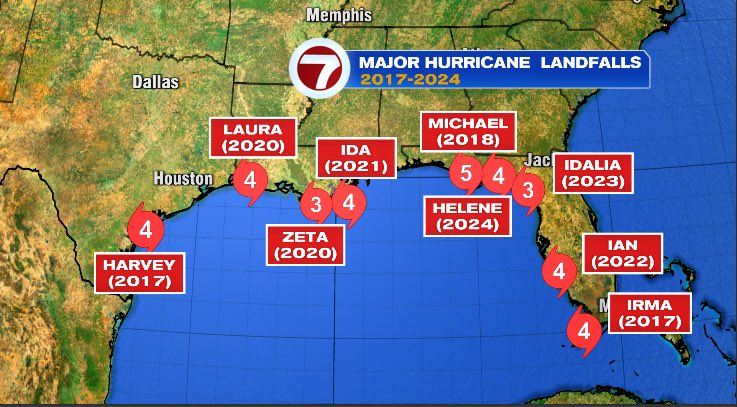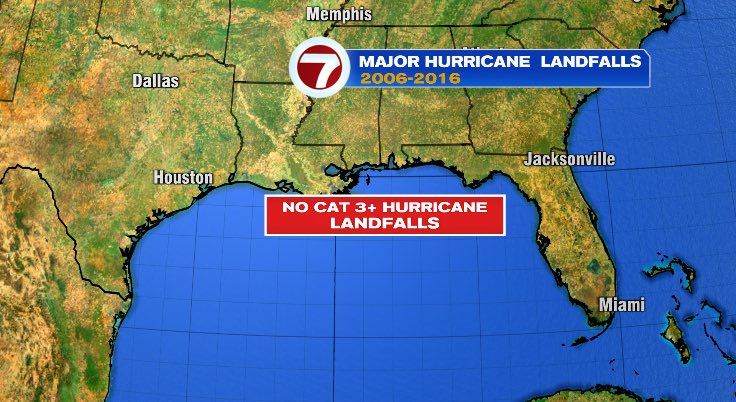(Updated October 10, 2024)
Cyclenall wrote:I didn't know where to put this but Helene continues the trend of an major increase in landfalling CAT4+ hurricanes since 2017. Certainly for the US but basin-wide too. Even during the historic 2003-2005 period it was just Charley. Then before that it was Andrew!
Here are the number of Cat 3 and Cat 4 CONUS landfalls compared in the 1995-2009 period vs. 2010-2024 period (so far). The two periods nicely divide up the current +AMO era evenly. Both periods include very active and/or destructive years (e.g. 1995, 1999, 2004, 2005, 2010, 2017, 2020).
1995-2009:
- Cat 3+: 10 hurricanes (Opal, Fran, Bret 1999, Charley, Ivan, Jeanne, Dennis, Katrina, Rita, Wilma)
- Cat 4+: 1 hurricane (Charley)
- Cat 3+: 10 hurricanes (Harvey, Irma, Michael, Laura, Zeta, Ida, Ian, Idalia, Helene, Milton)
- Cat 4+: 7 hurricanes (Harvey, Irma, Michael, Laura, Ida, Ian, Helene)
- Cat 5: 1 hurricane (Michael)
Gulf of Mexico was clearly the hot spot for such landfalls: Every single MH CONUS landfall since 2010 (equivalently, since 2017) did so on the Gulf coast. Whereas during 1995-2009, two of the 10 MH landfalls were on the US East Coast (Fran, Jeanne). However, the lack of East Coast MH landfalls may be a streak of good luck or a coincidence, as there were no shortage of threats (Matthew, Irma, Florence, Dorian).
Graphics from this tweet by Jeremy Reiner illustrates this perfectly:


Another trend in recent years is a significant increase in storms that strengthened all the way until landfall. In 1995-2009, 7 out of 10 MH landfalls were weakening at CONUS landfall, either slightly or significantly. But in 2010-2024, 7 out of 10 MH landfalls intensified, typically rapidly, until they were stopped by land.
Furthermore, MH landfalls have become more evenly distributed across individual years. Of the 10 MH landfalls in the earlier half of this +AMO era, 7 occurred within a span of 2 years, 2004 and 2005, both of which are legendary seasons themselves. That's not the case for the more recent half, where each year contributed at most 2 MH landfalls on CONUS (unless 2024's late season changes things). Yet, such intense hurricanes on the Gulf had become almost a yearly experience: 7 of the past 8 years had a CONUS MH landfall, and 6 of the 8 had a Cat 4+. They include El Nino years (2018, 2023) and years with near-average ACE (2022). The threat from a highly destructive major hurricane is clearly no longer limited to hyperactive years, shattering an impression that people may have gotten earlier from 2004-05.
Keep in mind, this is despite the latter period containing the very inactive years of 2013-15, and the textbook example 2010 with hyperactivity but sparing CONUS entirely. If 2010 had more west-based tracks typical of La Ninas, 2013 played out as forecast, and even the earlier parts of 2022 and 2024 were more active, the number may have been even higher.
A caveat is that the above calculations only consider peak wind speed, which is not the end-all (as we've just seen with Helene). Many destructive Cat 1-2 or even TS landfalls were omitted. However, they're also roughly evenly distributed across the two periods (Bertha 1996, Georges, Floyd, Allison, Lili, Isabel, Frances, Gustav, Ike / Irene, Isaac 2012, Sandy, Matthew, Florence, Imelda, Isaias, Sally, Beryl).





